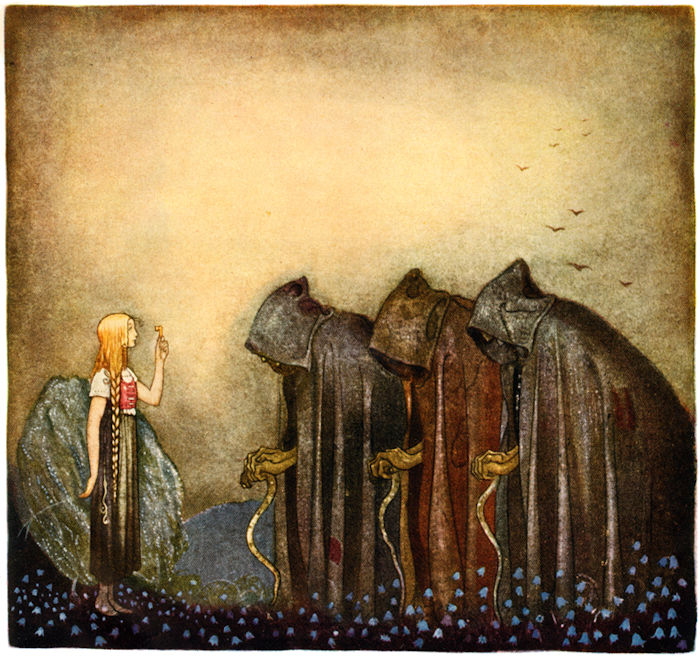Unusual Power Of Seidr: Norse Shamans Used Magic To Alter Destiny And See The Future
Ellen Lloyd - AncientPages.com - In Norse mythology, Seidr is the practice of magic and shamanism.
Shamans played a very important role in Norse society. These enigmatic beings were known for their unusual powers, and they were credited with the ability to alter destiny. Beings who mastered seidr were therefore as much feared as respected by people and even the Norse gods themselves.
Goddess Freya was the most powerful völva. Freya painting by James Doyle Penrose (1862-1932). Credit: Public Domain
Seidr – How Norse Shamanism Was Used
In his book, The Viking Way: Magic and Mind in Late Iron Age Scandinavia, author and archaeologist Neil Price explains how seidr was used in general. "There were seiðr rituals for divination and clairvoyance; for seeking out the hidden, both in the secrets of the mind and in physical locations; for healing the sick; for bringing good luck; for controlling the weather; for calling game animals and fish.
Importantly, it could also be used for the opposite of these things – to curse an individual or an enterprise; to blight the land and make it barren; to induce illness; to tell false futures and thus to set their recipients on the road to disaster; to injure, maim and kill, in domestic disputes and especially in battle."
Archaeological Evidence Shows Ancient Norse Shamans Did Exist
A Völva was a powerful female shaman, and her male counterpart was Vitki.
The practice of Seidr (in Old Norse, seiðr) is mentioned in many Norse sagas, and archaeologists have unearthed evidence of Norse shamans' existence.
A mysterious ancient grave with unusual artifacts that belonged to a Völva was found in Denmark. Some objects inside the grave suggest she was a Norse shaman. Scientists discovered an intriguing metal wand and seeds from the poisonous henbane plant inside her tomb. These two particular accessories are associated with a Norse shaman because the name Völva (vǫlva) is Old Norse and means "wand carrier" or "carrier of a magic staff".
The term Seidr originated from the ritual of the Norse to boil salt, which also happens to be a purification rite.
God Odin's Meeting With A Völva
Norse gods relied on the knowledge of a Seidr.
For example, when God Odin was determined to solve the mystery of his son's dreams, he mounted his horse, Slepnir, and made the long journey to the underworld, Nilfheim. There, he called up a Völva, and when she arose from her tomb, Odin introduced himself as Vegtam, the Wanderer, son of Valtam.

God Odin meets the Völva - Credit: Illustration by Carl Emil Doepler, 1905
The Völva gave him advice, but as soon as she recognized it was God Odin in disguise, she refused to answer any more questions and sank into her tomb, vowing to speak no more until God Loki's chains were unbound—that is, until the end of the world.
Female shamans were religious leaders of the Viking community, and they were usually required to invoke their deities, gods, or spirits, often before Viking warriors went to war.
Norns Were Masters Of Seidr
Being skilled in the art of magic and prophecy was considered important in the Norse community, as seidr was also God Odin's specialty. Norse shamans were said to possess the ability to shapeshift, send nightmares to people, and alter destiny.
Guldnyckeln by John Bauer (1882–1918). Credit: Public Domain
Norns, known as 'Shapers of Destiny' in Norse mythology, were masters of seidr.
The Norns were goddesses who ruled the fates of people and determined individuals' destinies and lifespans.
Three principal and very powerful Norns lived in the mysterious well of Urd ('fate'), which had its location beneath one of the roots of the giant ash tree – Yggdrasill (World Tree"), which formed a column linking the realms of the gods, humankind, the giants and the dead.
We encounter the Norns as goddesses of fate and destiny in Greek, Roman and Slavic mythology.
Updated on February 28, 2022
Written by Ellen Lloyd – AncientPages.com
Copyright © AncientPages.com All rights reserved. This material may not be published, broadcast, rewritten or redistributed in whole or part without the express written permission of AncientPages.com
More From Ancient Pages
-
 Salzburg Catacombs: Early Christian Place For Secret Gatherings And Hiding From Persecution
Featured Stories | Mar 16, 2016
Salzburg Catacombs: Early Christian Place For Secret Gatherings And Hiding From Persecution
Featured Stories | Mar 16, 2016 -
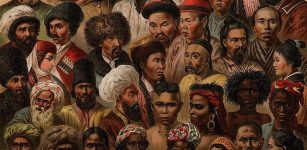 Ancient Trans-Atlantic Emigration Theory – Not Supported By Genetic Data, Researcher Says
Archaeology | Jan 18, 2016
Ancient Trans-Atlantic Emigration Theory – Not Supported By Genetic Data, Researcher Says
Archaeology | Jan 18, 2016 -
 What The Egg Crisis Reveals About Our Food System
Archaeology | Apr 24, 2023
What The Egg Crisis Reveals About Our Food System
Archaeology | Apr 24, 2023 -
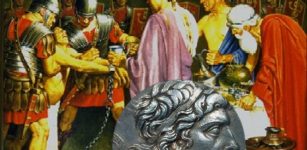 King Mithradates VI Of Pontus Used Poison To Avoid Death By Poison
Ancient History Facts | Mar 5, 2016
King Mithradates VI Of Pontus Used Poison To Avoid Death By Poison
Ancient History Facts | Mar 5, 2016 -
 Our Understanding Of Human Prehistory And Societies Is Wrong – Scientists Say
Featured Stories | Nov 3, 2022
Our Understanding Of Human Prehistory And Societies Is Wrong – Scientists Say
Featured Stories | Nov 3, 2022 -
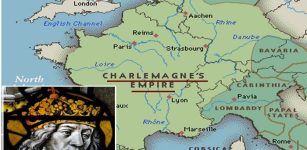 On This Day In History: Charlemagne Became The King Of The Franks – On Dec 5, 771
News | Dec 5, 2016
On This Day In History: Charlemagne Became The King Of The Franks – On Dec 5, 771
News | Dec 5, 2016 -
 Mystery Of The Okefenokee Swamp Deepens: Unexplained Sightings Of Unknown Beings, Puzzling Lights, And Giant Skeletons Reported
Featured Stories | Nov 26, 2024
Mystery Of The Okefenokee Swamp Deepens: Unexplained Sightings Of Unknown Beings, Puzzling Lights, And Giant Skeletons Reported
Featured Stories | Nov 26, 2024 -
 Similarities And Differences Between Living Spaces Of Neanderthals And Homo Sapiens
Archaeology | Apr 9, 2024
Similarities And Differences Between Living Spaces Of Neanderthals And Homo Sapiens
Archaeology | Apr 9, 2024 -
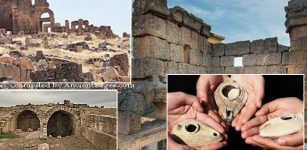 1,500-Year-Old Ancient Lamps Unearthed In Zerzevan Castle In Southeast Turkey
Archaeology | Nov 25, 2019
1,500-Year-Old Ancient Lamps Unearthed In Zerzevan Castle In Southeast Turkey
Archaeology | Nov 25, 2019 -
 Sverd I Fjell – Swords In Rock: Battle Of Hafrsfjord Won By Harald Fairhair – First King Of Norway
Featured Stories | Mar 9, 2016
Sverd I Fjell – Swords In Rock: Battle Of Hafrsfjord Won By Harald Fairhair – First King Of Norway
Featured Stories | Mar 9, 2016 -
 Mystery Of Famous Viking Ruler Rollo: DNA Experts Seek The Truth About His Identity
Featured Stories | Mar 16, 2016
Mystery Of Famous Viking Ruler Rollo: DNA Experts Seek The Truth About His Identity
Featured Stories | Mar 16, 2016 -
 Stone Age Statues Were Taken To Britain For Restoration In 1990 – Never Returned Home To Jordan
News | Apr 6, 2021
Stone Age Statues Were Taken To Britain For Restoration In 1990 – Never Returned Home To Jordan
News | Apr 6, 2021 -
 Artemisia I Of Caria – Pirate Queen And Ally Of Xerxes I Was Loyal To No-One Except Herself
Featured Stories | Jul 22, 2025
Artemisia I Of Caria – Pirate Queen And Ally Of Xerxes I Was Loyal To No-One Except Herself
Featured Stories | Jul 22, 2025 -
 Crosby-Schøyen Codex: Ancient Coptic Manuscript Reveals Sermon That Spurred Violence Against Jews
Featured Stories | Jun 5, 2024
Crosby-Schøyen Codex: Ancient Coptic Manuscript Reveals Sermon That Spurred Violence Against Jews
Featured Stories | Jun 5, 2024 -
 Discovery Of An Unusually Large Ancient Artifact May Confirm Powerful Myth Of A Mysterious Race
Featured Stories | Oct 8, 2024
Discovery Of An Unusually Large Ancient Artifact May Confirm Powerful Myth Of A Mysterious Race
Featured Stories | Oct 8, 2024 -
 Library Of Celsus: Beautiful Classic Monument In Ephesus That Stored 12,000 Scrolls
Civilizations | Nov 14, 2018
Library Of Celsus: Beautiful Classic Monument In Ephesus That Stored 12,000 Scrolls
Civilizations | Nov 14, 2018 -
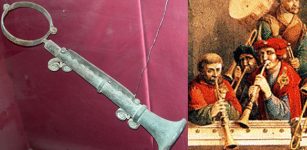 What Was The Medieval Shame Flute?
Ancient History Facts | Jan 27, 2020
What Was The Medieval Shame Flute?
Ancient History Facts | Jan 27, 2020 -
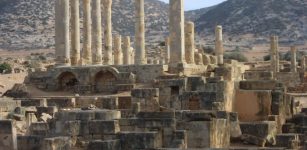 University Of Warsaw Archaeologists Return To Study Large Ancient City Of Ptolemais
Archaeology | Sep 8, 2023
University Of Warsaw Archaeologists Return To Study Large Ancient City Of Ptolemais
Archaeology | Sep 8, 2023 -
 Unique Chachabamba Complex Hidden In Peruvian Forest Reveals Its Secrets
Archaeology | Feb 7, 2019
Unique Chachabamba Complex Hidden In Peruvian Forest Reveals Its Secrets
Archaeology | Feb 7, 2019 -
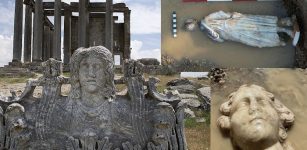 More Greek Gods’ Heads And A Life-Sized Statue Of A Man Unearthed In The Ancient City Of Aizanoi
Archaeology | Dec 28, 2022
More Greek Gods’ Heads And A Life-Sized Statue Of A Man Unearthed In The Ancient City Of Aizanoi
Archaeology | Dec 28, 2022


